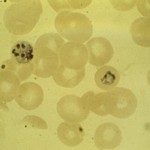Link to Pubmed [PMID] – 38056460
Link to HAL – hal-04325463
Link to DOI – 10.1016/j.chom.2023.11.007
Cell Host & Microbe, In press, ⟨10.1016/j.chom.2023.11.007⟩
Vivax malaria has long been thought to be absent from sub-Saharan Africa owing to the high proportion of individuals lacking the Duffy antigen receptor for chemokines (DARC) in their erythrocytes. The interaction between P. vivax Duffy-binding protein (PvDBP) and DARC is assumed to be the main pathway used by merozoites to invade reticulocytes. However, the increasing number of reports of vivax malaria cases in genotypically Duffy-negative (DN) individuals has raised questions regarding the P. vivax invasion pathway(s). Here, we show that a subset of DN erythroblasts transiently express DARC during terminal erythroid differentiation and that P. vivax merozoites, irrespective of their origin, can invade DARC+ DN erythroblasts. These findings reveal that a large number of DN individuals may represent a silent reservoir of deep P. vivax infections at the sites of active erythropoiesis with low or no parasitemia, and it may represent an underesti- mated biological problem with potential clinical consequences in sub-Saharan Africa.






